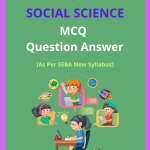SEBA Class 8 Social Science MCQ Chapter 23 Indian Constitution Solutions in English Medium, Class 8 Social Science Multiple Choice Question Answer to each chapter is provided in the list so that you can easily browse throughout different chapters SEBA Class 8 Social Science MCQ Chapter 23 Indian Constitution Question Answer and select need one.
SEBA Class 8 Social Science MCQ Chapter 23 Indian Constitution
Also, you can read the SCERT book online in these sections SEBA Class 8 Social Science Objective Type Solutions by Expert Teachers as per SCERT (CBSE) Book guidelines. These solutions are part of SCERT All Subject Solutions. Here we have given Assam SEBA Class 8 Social Science MCQ Solutions for All Subject, You can practice these here.
Indian Constitution
Chapter – 23
| MCQ |
1. What event prompted the British Crown to take direct control of India?
(a) The Sepoy Mutiny of 1857.
(b) The Indian Councils Act of 1861.
(c) The Government of India Act of 1919.
(d) The Simon Commission Report.
Answer: (a) The Sepoy Mutiny of 1857.
2. Which Act introduced the representative system of administration in India?
(a) The Indian Councils Act of 1861.
(b) The Government of India Act of 1909.
(c) The Government of India Act of 1919.
(d) The Government of India Act of 1935.
Answer: (a) The Indian Councils Act of 1861.
3. Who was the chairman of the Drafting Committee of the Constituent Assembly?
(a) Jawaharlal Nehru.
(b) B.R. Ambedkar.
(c) Mahatma Gandhi.
(d) Rajendra Prasad.
Answer: (b) B.R. Ambedkar.
4. Which Act introduced the concept of diarchy in India?
(a) The Indian Councils Act of 1861.
(b) The Government of India Act of 1909.
(c) The Government of India Act of 1919.
(d) The Government of India Act of 1935.
Answer: (c) The Government of India Act of 1919.
5. Which report recommended the formation of a Constituent Assembly for India?
(a) The Nehru Report.
(b) The Simon Commission Report.
(c) The Cabinet Mission Plan.
(d) The August Offer.
Answer: (a) The Nehru Report.
6. Which constitutional principle was borrowed from the Constitution of the United States?
(a) Parliamentary democracy.
(b) Directive Principles of State Policy.
(c) Fundamental Rights.
(d) Federalism.
Answer: (c) Fundamental Rights.
7. When was the Indian Constitution adopted by the Constituent Assembly?
(a) August 15, 1947.
(b) November 26, 1949.
(c) January 26, 1950.
(d) December 11, 1946.
Answer: (b) November 26, 1949.
8. Which event led to the British government accepting the demand for a separate Constituent Assembly?
(a) The Sepoy Mutiny of 1857.
(b) The Indian Councils Act of 1861.
(c) The Cabinet Mission Plan.
(d) The Simon Commission Report.
Answer: (c) The Cabinet Mission Plan.
9. Who was the first President of India?
(a) Jawaharlal Nehru.
(b) B.R. Ambedkar.
(c) Mahatma Gandhi.
(d) Rajendra Prasad.
Answer: (d) Rajendra Prasad.
10. Which constitutional principle was borrowed from the Constitution of Canada?
(a) Parliamentary democracy.
(b) Directive Principles of State Policy.
(c) Fundamental Rights.
(d) Federalism.
Answer: (d) Federalism.
11. What is the name of the written document that incorporates the rules for the functioning of a country?
(a) Constitution.
(b) Law.
(c) Policy.
(d) Code.
Answer: (a) Constitution.
12. Why is a constitution necessary for a country?
(a) To establish a monarchy.
(b) To ensure smooth functioning and provide security to citizens.
(c) To limit the power of the judiciary.
(d) To promote a specific religion.
Answer: (b) To ensure smooth functioning and provide security to citizens.
13. What do you understand by “amendment” to the constitution?
(a) Changing the entire constitution.
(b) The process of making changes to the constitution.
(c) A suggestion for improving the constitution.
(d) A new constitution replacing the old one.
Answer: (b) The process of making changes to the constitution.
14. Which of the following is NOT a characteristic of a constitution?
(a) It is a set of written rules and principles.
(b) It determines relationships between government organs.
(c) It provides for fundamental rights and duties.
(d) It is a static document that never changes.
Answer: (d) It is a static document that never changes.
15. How does a constitution contribute to individual freedom and rights?
(a) By limiting the power of the government.
(b) By promoting a specific ideology.
(c) By establishing a rigid social hierarchy.
(d) By encouraging conformity.
Answer: (a) By limiting the power of the government.

Hi! my Name is Parimal Roy. I have completed my Bachelor’s degree in Philosophy (B.A.) from Silapathar General College. Currently, I am working as an HR Manager at Dev Library. It is a website that provides study materials for students from Class 3 to 12, including SCERT and NCERT notes. It also offers resources for BA, B.Com, B.Sc, and Computer Science, along with postgraduate notes. Besides study materials, the website has novels, eBooks, health and finance articles, biographies, quotes, and more.




